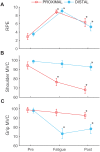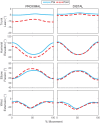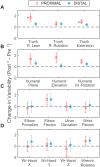Proximal and distal muscle fatigue differentially affect movement coordination
- PMID: 28235005
- PMCID: PMC5325574
- DOI: 10.1371/journal.pone.0172835
Proximal and distal muscle fatigue differentially affect movement coordination
Abstract
Muscle fatigue can cause people to change their movement patterns and these changes could contribute to acute or overuse injuries. However, these effects depend on which muscles are fatigued. The purpose of this study was to determine the differential effects of proximal and distal upper extremity muscle fatigue on repetitive movements. Fourteen subjects completed a repetitive ratcheting task before and after a fatigue protocol on separate days. The fatigue protocol either fatigued the proximal (shoulder flexor) or distal (finger flexor) muscles. Pre/Post changes in trunk, shoulder, elbow, and wrist kinematics were compared to determine how proximal and distal fatigue affected multi-joint movement patterns and variability. Proximal fatigue caused a significant increase (7°, p < 0.005) in trunk lean and velocity, reduced humeral elevation (11°, p < 0.005), and increased elbow flexion (4°, p < 0.01). In contrast, distal fatigue caused small but significant changes in trunk angles (2°, p < 0.05), increased velocity of wrench movement relative to the hand (17°/s, p < 0.001), and earlier wrist extension (4%, p < 0.005). Movement variability increased at proximal joints but not distal joints after both fatigue protocols (p < 0.05). Varying movements at proximal joints may help people adapt to fatigue at either proximal or distal joints. The identified differences between proximal and distal muscle fatigue adaptations could facilitate risk assessment of occupational tasks.
Conflict of interest statement
Figures






Similar articles
-
Effects of different fatigue locations on upper body kinematics and inter-joint coordination in a repetitive pointing task.PLoS One. 2019 Dec 31;14(12):e0227247. doi: 10.1371/journal.pone.0227247. eCollection 2019. PLoS One. 2019. PMID: 31891644 Free PMC article.
-
Changes in movement variability and task performance during a fatiguing repetitive pointing task.J Biomech. 2018 Jul 25;76:212-219. doi: 10.1016/j.jbiomech.2018.05.025. Epub 2018 Jun 13. J Biomech. 2018. PMID: 29908654
-
Differences in multi-joint kinematic patterns of repetitive hammering in healthy, fatigued and shoulder-injured individuals.Clin Biomech (Bristol). 2005 Jul;20(6):581-90. doi: 10.1016/j.clinbiomech.2005.02.012. Epub 2005 Apr 14. Clin Biomech (Bristol). 2005. PMID: 15927734
-
ISB recommendation on definitions of joint coordinate systems of various joints for the reporting of human joint motion--Part II: shoulder, elbow, wrist and hand.J Biomech. 2005 May;38(5):981-992. doi: 10.1016/j.jbiomech.2004.05.042. J Biomech. 2005. PMID: 15844264 Review.
-
The Response of the Shoulder Complex to Repetitive Work: Implications for Workplace Design.Crit Rev Biomed Eng. 2015;43(1):21-32. doi: 10.1615/critrevbiomedeng.2015014059. Crit Rev Biomed Eng. 2015. PMID: 26351021 Review.
Cited by
-
Effects of different fatigue locations on upper body kinematics and inter-joint coordination in a repetitive pointing task.PLoS One. 2019 Dec 31;14(12):e0227247. doi: 10.1371/journal.pone.0227247. eCollection 2019. PLoS One. 2019. PMID: 31891644 Free PMC article.
-
Sex-specific effects of localized muscle fatigue on upper body kinematics during a repetitive pointing task.BMC Musculoskelet Disord. 2022 Jun 27;23(1):613. doi: 10.1186/s12891-022-05566-5. BMC Musculoskelet Disord. 2022. PMID: 35761276 Free PMC article.
-
A Subject-Specific Approach to Detect Fatigue-Related Changes in Spine Motion Using Wearable Sensors.Sensors (Basel). 2020 May 6;20(9):2646. doi: 10.3390/s20092646. Sensors (Basel). 2020. PMID: 32384664 Free PMC article.
-
EEG Spectral Feature Modulations Associated With Fatigue in Robot-Mediated Upper Limb Gross and Fine Motor Interactions.Front Neurorobot. 2022 Jan 20;15:788494. doi: 10.3389/fnbot.2021.788494. eCollection 2021. Front Neurorobot. 2022. PMID: 35126082 Free PMC article.
-
The use of a three-dimensional dynamic arm support prevents the development of muscle fatigue during repetitive manual tasks in healthy individuals.PLoS One. 2022 Apr 1;17(4):e0266390. doi: 10.1371/journal.pone.0266390. eCollection 2022. PLoS One. 2022. PMID: 35363820 Free PMC article.
References
-
- Nonfatal Occupational Injuries and Illnesses Requiring Days Away from Work, 2014 [Internet]. 2015; December 16, 2014 [cited 1/15/2015]; [31]. http://www.bls.gov/news.release/pdf/osh2.pdf
-
- Enoka RM, Stuart DG. Neurobiology of muscle fatigue. Journal of Applied Physiology. 1992;72(5):1631–48. - PubMed
-
- Wilder DG, Aleksiev AR, Magnusson ML, Pope MH, Spratt KF, Goel VK. Muscular response to sudden load. A tool to evaluate fatigue and rehabilitation. Spine. 1996;21(22):2628–39. Epub 1996/11/15. - PubMed
MeSH terms
LinkOut - more resources
Full Text Sources
Other Literature Sources

